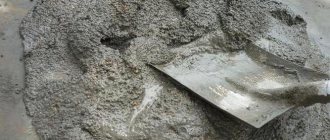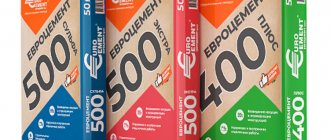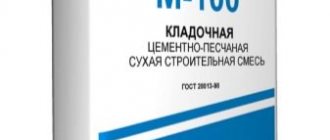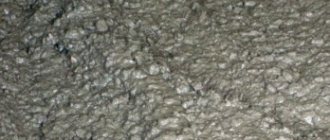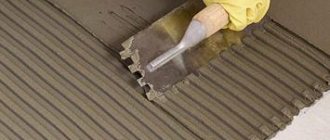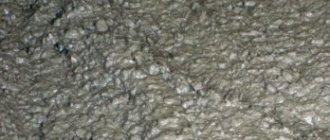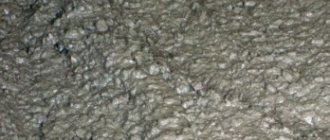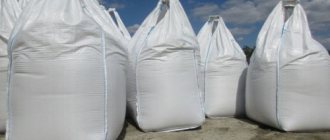M300 cement is used during construction work to connect elements, as well as in the production of reinforced concrete products or when pouring monolithic structures. The material provides increased strength of joints; use at low ambient temperatures is allowed (with additional heating for correct hardening).
Scope and characteristics of cement M300
Cements differ in both types and brands. Their varieties are characterized by GOST 26633-91. The main criteria for classifying cements are their composition, strength, setting speed, decorative properties and resistance to deformation. One of the most popular brands is M300 cement. Three hundredth is used mainly for the production of masonry and plaster mortars.
Technical characteristics of cement M300
Cement 300 has an alphanumeric designation according to SNiP 2.03.01-84, which indicates one of its characteristics - the compressive strength, which has a value corresponding to 22.5 MPa, or 300 kgf/sq.cm. This indicator has a direct relationship with the density of the binder.
Cement mortar M300 for brick laying.
Specific gravity is another characteristic that is an important indicator in determining the percentage of binder in solutions and various building mixtures. The average density of M300 cement is 1300 kg per m³.
During production, the basis is brought to the required standard indicators, using various kinds of additives of mineral and organic origin. Additives give the final product such technical characteristics as plasticity, water resistance, and reduce curing time.
Bulk density is another characteristic that affects the transportation of the finished binder and the duration of its dry storage. The parameter can have a value from the minimum, 1100 kg/cub.m, to the maximum permissible, 1600 kg/cub.m. The fresher the product, the lower the bulk density value; the older it is, the higher it is. This technical parameter can be influenced by various additives, such as plasticizers and special-purpose additives.
An important parameter characterizing the material is the setting time of the mixture, which for the brand in question is at least 75 minutes. The uniformity of volume change during hardening, or expansion, is no more than 10 mm.
It is necessary to describe a feature of the technical characteristics of cement - it is a slow increase in strength compared to other brands. Nevertheless, a fully hardened stone has good water resistance and is highly resistant to corrosion.
Why and where is M300 cement used?
The main area of application for grade 300 cement is use in masonry and plaster mortars, which is due to the increased plasticity of ready-made mixtures based on it.
For plastering work, a mixture is used - cement-sand mortar in the classic ratio of 1:3, that is, 3 parts of sand are taken for 1 part of the binder. If increased plasticity of the solution and application in a thin layer are required, for example, during facade work, then various additives are added to its composition.
When laying bricks and blocks, a 1:4 ratio (binder and sand) is used to prepare a mortar based on M300. To increase the plasticity of the finished solution, you can also use special additives.
To perform floor screeds, the brand in question is rarely used, but if necessary, a 1:3 ratio (binder and sand) is used.
The grade is not used for the manufacture of concrete and foundation masonry; in these cases, it is preferable to use M400 or M500.
Source
Preparation of concrete M300
Concrete is an indispensable material in construction. But many still think that concrete is concrete in Africa, that is, it is always and everywhere the same. But this is far from true. Concrete is divided into numerous classes and grades for different indicators. The most common indicator is the strength of concrete, which is denoted by the letter M and a numerical value (M150, M200, M300, etc.).
Pouring concrete formwork
Why M 300
Concrete M300 is the most common grade of concrete with the widest range of uses. The density of M300 concrete allows it to be used in the construction of road and airfield pavements, bridges, foundations, various reinforced concrete structures, hydraulic structures, etc.
The composition of M300 concrete is no different from similar brands. The same cement, water, sand and filler. To prepare M300 concrete, different types of fillers are used:
- gravel,
- limestone,
- granite.
Review of properties and characteristics of DSP brand M-300
When constructing capital structures, it is advisable to use a cement-sand mixture to prepare the mortar, into which, keeping the proportions, you can add various additives and fillers. The use of ready-made dry sand concrete allows you to accurately predict the characteristics of the resulting surface, the consumption of the product per 1 m2, and the completion time of the object. DSPs that differ in the ratio of components are intended for different categories of work. Of these, M300 produces the highest strength concrete and can be used in most cases.
A branded mixture of sand and cement has several preparation options. For plastering operations, use CPS with the inclusion of lime (M100). For masonry and general construction compositions, M150 and M200 are used. The M300 effectively performs its tasks in concreting, eliminating large defects in the monolith, and leveling foundations. On the packaging and in the price list, this particular brand is designated as sand concrete.
It is suitable for the construction of objects that do not have special requirements for operating conditions. The solution obtained from it is selected for carrying out external and internal types of work. M300 produces dry screed that meets all standards. The cost ratio is clearly not in favor of purchasing branded concrete.
The technical parameters of the M300 CPS are established by GOST 7473-94 and are expressed in the following indicators:
- Compressive strength. The ability of a finished structure to withstand a certain load. For M300 - up to 9.81 kg/cm2 (30 MPa).
- Range of permitted temperatures for pouring. It is recommended to use at +5-25°C. With lower environmental characteristics, it is necessary to ensure heating of fresh concrete using appropriate technology.
- Frost resistance. If the proportions of mixing with CPS water are observed, the frozen solution will withstand freezing/thawing up to 50 cycles. This allows use in the construction of unheated buildings and utility rooms.
- Adhesion. The dried composition adheres to the treated base and will require a force exceeding 4 kg/cm2 to tear it off.
Cement-sand mixture brand M300
Sand concrete brand M300 is the most versatile ready-made cement-sand mixture of all those available for sale (one of the popular brands is described in the article Cement-sand mixture M300 Stone Flower). Representing an ordinary mortar for masonry and screed, it is successfully used both as high-strength plaster and as concrete. By introducing various additives, this material can be used as a basis for any cement composition needed at a construction site.
It differs from manually prepared CPS in the absence of shrinkage during hardening, characteristics guaranteed by the manufacturer. Making a solution that is pre-mixed in dry form is an order of magnitude easier than preparing the composition yourself from individual components. In addition, ready-mixed mixtures are less susceptible to caking and loss of strength over time than bagged cement. The advantages also include high plasticity, mobility, which facilitates work, and low water permeability.
The composition of high-quality sand concrete M300 includes:
- Portland cement grade M500 - about 25% of weight;
- fractionated sand, granite screenings, crushed stone chips 1-5 mm - about 75%;
- mineral additives (plasticizers, antifreeze, hydrophobic, and so on), fiberglass - optional, depending on the purpose of the mixture and the required characteristics.
Typically, the composition includes filler of two fractions - coarse screenings or crumbs (4 - 8 mm), and medium-grained quartz sand (0.8 - 2 mm). This allows you to achieve maximum strength and non-shrinkage with minimal binder costs. In cheaper materials, washed sand 1 - 5 mm is used.
1. Brand compressive strength - sand concrete must withstand a pressure of 30 MPa a month after hardening; testing takes place in the laboratory when setting up dosing equipment. The presence of fine fractions and dust in construction sand, the approximate nature of dosing, and the use of compacted cement do not allow achieving the same guaranteed results when making CSP independently.
2. Maximum filler fraction - determines the main purpose of the mixture. Gravel 5 - 8 mm is taken when casting reinforced concrete structures, slabs and blocks, screenings 2 - 5 mm are used for screeding and the production of concrete products (curbs, paving slabs, Euro fences). There are types with especially fine grains of filler, designed for decorative and plastering work.
3. Water permeability is practically zero; after gaining strength, the remaining moisture in the material is less than 1%. Special additives help achieve even lower values acceptable for underground and underwater structures.
4. Frost resistance - the number of freeze-thaw cycles before the onset of destructive processes. Approximately, it can be taken as a period of impeccable service in years in the central zone and northern regions of Russia. Typical parameters are F35-F50.
5. Water holding capacity is an important characteristic for installation work. Severe loss of water from the solution leads to the formation of cracks and loss of strength. In high-quality mixtures, values of 95% and higher are achieved.
6. Range of operating temperatures - the compositions are designed for installation at temperatures of 5 - 30 degrees; with winter options, you can work effectively at 5 degrees below zero.
7. Setting time. From mixing to the start of the cement hydration process - 2 hours, but the value can vary within very wide limits under the influence of gypsum additives, low or high temperature, and constant stirring.
The ratio of components in the concrete mixture is selected in such a way that small filler particles evenly fill the space between large ones, therefore the density and consumption of the material are slightly higher than for conventional CFRP. In order to take into account costs at the planning stage, it is necessary to calculate the total volume of concrete poured depending on the type of work:
For casting reinforced concrete structures and monolithic walls, standard geometric formulas are used without taking into account reinforcement.
- Technological consumption rates are used for masonry.
- For plastering and pouring floors, calculate the total area of the treated surface and the average thickness of the mortar layer. The average distance from the base to the markings (beacons) is determined by measuring in several places along the entire plane.
On the packaging of the purchased mixture, costs are indicated in the format “sand concrete consumption per 1 m2, taking into account a layer thickness of 1 cm,” the usual values are 18-22 kg. The consumption per 1 m3 of solution can be obtained by multiplying the specified characteristic by 100.
Where is it used?
The main purpose is to create a high-strength, wear-resistant floor screed for further use without additional coating. Its widespread use is for the restoration of partially crumbled or cracked reinforced concrete structures, the manufacture of concrete products, and paving slabs. DSP is suitable for masonry or plaster mortar; for this, choose a type of material with no grains larger than 4 and 2 mm, respectively. It is easy to make expanded clay concrete or M200 from the finished mixture by adding expanded clay or crushed stone 1 to 1 (in volumes of dry material).
Precise guidance on the ratio of water and dry mixture, allowable working time and setting time is included with the product, and may vary depending on the composition. Average indicators are 1.5-2 liters of water per 10 kg, 1-2 hours to work with the solution, 1-2 days for hardening, a month to gain full strength. Excess water causes shrinkage, cracks and reduced performance.
Purchase costs
When trying to save on building materials, you need to consider the following factors:
1. The vast majority of brands of sand concrete are supplied exclusively in bags weighing 25 - 50 kg, rare offers of goods in MKR are unprofitable in price, and when purchasing nameless mixtures in bulk there are no guarantees of quality.
2. The greater the weight of the bag and the more inconvenient the unloading, the cheaper the purchase will be. Cost savings can reach 10-20%.
3. By buying in bulk, you will be able to reduce costs by 5–15%, but do not forget that the shelf life of this material does not exceed six months. You will need a dry, spacious room for pallets.
4. When choosing a supplier, first of all you need to find out the delivery price - an unsuccessful warehouse location can increase total costs by 20 - 50%.
5. Before you buy a product that stands out for its particularly low price, you should read reviews and customer reviews. Perhaps its technical characteristics are insufficient to perform the assigned tasks or do not correspond to the declared ones.
The cost of sand concrete M300 in Moscow excluding delivery:
| Name of dry mixture | Bag weight, kg | Cost of the bag, rubles | Price per ton, rubles |
| Stone flower M300 | 25 | 90 | 3600 |
| 40 | 120 | 3000 | |
| 50 | 145 | 2900 | |
| LUIX M300 Roussean | 40 | 130 | 3250 |
| Stock M300 Kreptsem | 30 | 100 | 3300 |
| 40 | 130 | 3250 | |
| 50 | 155 | 3100 | |
| Sand concrete Etalon M300 | 40 | 110 | 2750 |
| TsPS Finstroy M300 | 40 | 105 | 2620 |
| 25 | 70 | 2800 | |
| Rusean M300 | 40 | 145 | 3620 |
For comparison: 1 ton of dry mixture, prepared independently from granite screenings, cement and ordinary sand, will cost approximately 1,500 - 1,700 rubles.
The most reputable manufacturers in Russia are and. Both suppliers have production in the Moscow region and warehouses with the possibility of rail and road delivery to any European city in Russia. The “Stone Flower” sand concrete is suitable for a thrifty customer with average needs, and the “Rusean” mixture is suitable for a demanding customer who is willing to pay a little extra for quality.
Application of sand concrete
Branded cement mixture is selected for concreting coatings with a load of about 250-300 kg/cm². According to this indicator, M300 is suitable for installing a high-strength, wear-resistant floor in a basement, utility room, technical or residential area.
CPS depending on the sand fraction:
- Small (0.8-1.2 mm). For external work with high-strength mounting mortar, masonry of critical structures, concreting light screed (up to 5 cm thick).
- Medium (1.8-2.2 mm). Application from inside the premises, installation of curbs, euro fences, paving slabs, screed up to 10 cm, installation of a heated floor system.
- Large (2.5-4 mm). The presence of sand particles of this size in M300 reduces moisture absorption. This sand concrete is used for strip, slab and column foundations, floor slabs, and plinths.
There are no restrictions on the thickness of the applied layer if structural reinforcement is used.
Component proportions and DSP consumption
The standard cement composition includes 1 part of Portland cement of the brands PTs400 D0, PTs500 D20 and 2 times more dried sand of standardized fractions. Polymer and mineral additives may be included to improve certain characteristics:
- plastic;
- frost resistance;
- moisture resistance;
- thermal conductivity;
- resistance to abrasive influences.
Fiber and microsilica may be added by the manufacturer.
In terms of efficiency, the consumption of such a mixture per 1 m2 is quite low. As the size of the M300 layer increases, the costs of sand concrete increase:
- for 1 mm of solution application thickness, about 1.7 kg/m2 is used;
- at 2 mm there is an increase to 3.5 kg for the same area;
- for a 10 mm screed you need 22 kg of dry compound per 1 m2.
The exact consumption of M-300 must be looked at on the packaging, since it differs from different manufacturers and can range from 18 to 30 kg/m2. For pouring screeds, higher values are calculated, since its thickness is standardized by SNiPs from 50 mm.
Independent preparation of sand concrete
Technologically, it is possible to make a cement mortar if the ratio of components is strictly observed. For this purpose, sand should be purchased separately. In ready-to-use form, it is sold in 25 kg bags. It is quite difficult to independently obtain clean and dry material of the required fraction.
The proportions of cement and filler depend on the type of structure being constructed:
- Portland cement M400 and sand are used for the screed in a ratio of 1:3. To increase the strength of the base, it is recommended to add fiberglass if you do not reinforce the monolith.
- In plaster the proportion changes to 2:3. The liquid mass needs to be worked out urgently, as it dries quickly and loses its plasticity. Mixing the components begins in dry form until a mixture is obtained that is uniform in density and color.
M300 is mixed with cold water (up to +20°C) without mineral impurities. Its consumption is determined by the ratio: 10 kg of dry sand concrete will require 1.7 liters of liquid. To mix the DSP, take an electric drill with a mixing attachment. As a second step, for larger volumes you can use a concrete mixer. To improve the quality of mixing, 2/3 of the required amount of the composition is first poured into the drum, the rest is added in portions while the equipment is constantly operating.
As a result, you need to obtain a homogeneous, viscous and plastic solution, which is kept in a calm state for 5-10 minutes before use. It is poured and leveled on the base with a rule (spatula). Air bubbles are removed by bayoneting or a vibrator.
Price for DSP
Sand concrete is available for purchase from almost all retailers. The cost largely depends on the manufacturer and the weight of the package. The average price of a 40 kg bag of M300 brand is in the range of 100-150 rubles. Independent preparation of 1 ton of standard composition from prepared sand, Portland cement, adding granite screenings will cost 1500-1800 rubles.
Among industrially manufactured DSPs, the following brands are distinguished by their popularity (and low cost):
The guaranteed high quality of Rusean is also evident in the fact that the declared strength (30.4 MPa) is higher than the standard for the M300 line (30 MPa).
| Sand concrete | Packaging, kg | Price, rubles | Offer |
| Stone Flower | 40 | 144 | Building yard |
| 145,2 | Isolux.ru (IM) | ||
| 125 | Construction Alpha | ||
| 50 | 174 | Building yard | |
| Isolux.ru (IM) | |||
| 157 | Construction Alpha | ||
| 189 | Bafus | ||
| Rusean | 40 | 154 | Building yard |
| 125 (Luix) | Construction Alpha | ||
| 145 | |||
| Master Harz Roller FC30 | 50 | 204 | Isolux.ru (IM) |
| MKU | 40 | 135 | StroyShopper |
| 100 | Construction Alpha | ||
| Finstroy | 95 | ||
| Anchor | 105 | ||
| Sand concrete300 | 133 | Leroy Merlin | |
| 50 | 185 | StroyShopper |
Source
Concrete mix grade M300
Concrete mixtures have been used in construction for at least two centuries. All qualitative characteristics of the artificial stone obtained after its hardening are included in the concept of “concrete grade”. The most widely used mixture these days is the one designated M300, the features of which are worth taking a closer look at.
Properties, characteristics and proportions of concrete
The M300 has both positive and negative sides. The advantages of 300-m concrete are:
- high strength, reliability and durability of manufactured structures;
- resistance to low temperatures;
- moisture resistance;
- fire resistance;
- increased firmness and elasticity;
- the ability to modify the mixture using various additives.
At the same time, the M300 brand is demanding in terms of manufacturing technology: careful compaction is required, proportions and water-cement ratio must be strictly observed. Excess water does not increase the mobility of the solution - it can delaminate and lose strength. The same result is likely with large temperature changes during concrete work. To maintain the condition of the mixture in cold weather (down to -18 o), it is advisable to add an anti-frost component to it.
Technical characteristics of concrete
The rules for marking concrete are established by GOST - it also determines the brand and class of the composite material. These are the main quality criteria, which are influenced by the ratio of components.
Building material with code M300 refers to heavy concrete: its grade indicates a fairly high density (average value -1.85-2.5 t/m3, depending on the type of crushed stone). This allows the solution to be used for the construction of structures subject to constant force loads. In addition to the grade, concrete is characterized by a strength indicator expressed in SI units - megapascals (MPa). The strength of the M300 mixture corresponds to class B22.5.
In addition to the main parameters, there are additional ones:
- frost resistance F (the number of cycles of freezing and defrosting concrete without reducing the strength class), for the M300 material the frost resistance is close to 150;
- water resistance W – water pressure in MPa/10 required for its penetration to a depth of 15 cm; for concrete M300 the indicator should not be lower than W5–W6;
- mobility (workability) P - it varies from P1 to P5 (if concrete is poured with a pump, higher mobility is achieved with the help of plasticizers - P4-P5).
Composition of the mixture, requirements for ingredients
The traditional recipe for heavy concrete grade M300 includes binder (cement or Portland cement), water and aggregates - crushed stone, gravel, sand. Water and cement allow you to obtain a homogeneous solution. Filling components ensure the formation of a structural skeleton that absorbs the main force load and acts as a shock absorber. In addition, the use of aggregates reduces the cost of concrete per cubic meter.
The proportions of the composition of concrete with the designation M300 in volumetric ratio look like this:
- Portland cement M400 or M500 – 1 hour;
- water – 0.6 hours;
- sand – 1.9 parts (if using PC brand M400) or 2.4 (when using PC M500);
- medium-fraction granite crushed stone - 2.8 or 4.3 parts, respectively.
The table shows the weight composition of the M300 concrete mixture to obtain one cubic meter of the finished product.
Proportions of materials for mixing concrete:
| Brand of Portland cement | Cement, kg | Water, kg | Sand, kg | Crushed stone, kg |
| M400 | 382 | 220 | 705 | 1080 |
| M500 | 300 | 180 | 720 | 1290 |
The higher the grade of binder, the less its amount in the concrete. If the humidity of cement or sand is high, the volume of water may be reduced.
The solution includes components that meet a number of requirements.
- The recommended grade of cement exceeds the standard strength of concrete three times, and Portland cement - twice. Usually, to prepare the M300 mixture, cement powder of the M500 class (sometimes M400) is taken.
- The water is clean, preferably settled.
- Sand does not have clay impurities.
- The composition of the M300 solution includes coarse aggregate, the strength grade of which is approximately twice as high. If the basis of crushed stone is granite or limestone, its strength should be in the range of 500-600. The permissible strength indicators of gravel filler increase to 800-1000.
The table shows the differences in the concrete mixture depending on the origin of the crushed stone:
Fillers are selected so that they are of different fractions. This will reduce the gaps between them, increasing the density and strength of the finished product. To reduce the consumption of cement and sand, it is desirable to achieve minimal voids. Acceptable ratio of voids in the components of the M300 mixture:
- in crushed stone – 50%;
- in gravel – 45%;
- in sand – 37%.
When preparing the M300 concrete composition on your own, sometimes broken brick or clay sand is used instead of crushed stone. In this case, it will not be possible to achieve concrete strength and frost resistance values that correspond to standard indicators.
Application of M300 mixture
What does it consist of?
The use of M300 sand concrete makes it easier to create a solution. The material cakes less (compared to cement) and retains its strength for a long time.
It contains:
- cement (cement M500, 400 or 300);
- crushed stone chips (up to 5 mm);
- fractionated sand;
- fractional sand;
- granite screening.
The amount of ingredients may differ among individual manufacturers, although in most cases M300 sand concrete has the same composition and proportions. Additives are added to give the mixture the desired properties. Plasticizers, hydrophobic and antifreeze substances can be added to the mixture. If required, add fiber fiber.
There are 2 types of filler:
- crumbs or screenings measuring 4-8 mm;
- medium-grained sand 0.8-2 mm.
Advantages and disadvantages
The grade of material means the greatest weight (kg) that the screed can withstand per 1 m³. M300 is quite durable, but it is important to consider the application features.
Sand concrete mixture enjoys the trust of buyers.
Compared to other materials, the solution has the following advantages:
- The dry sand concrete mixture M300 is sold ready-made; all that remains is to add the required amount of water. The consumption per 1 m2 of screed is indicated by the manufacturer in the instructions.
- Fast hardening.
- Low water permeability.
- High strength, frost and wear resistance of hardened bases.
- Suitable for indoor and outdoor use.
- Environmentally friendly.
- Resistance to mechanical stress.
- Plasticity (the ability to easily take the desired shape), not afraid of corrosion.
- Good adhesion to different materials.
When the material has completely cured and reached maximum strength, the moisture content is 0.9%.
Dry mix M 300 sand concrete has several disadvantages:
- As a result of increased material consumption, the cost of the base increases. This becomes unprofitable (compared to buying cement and sand). At the same time, preparing the mixture with your own hands does not require special knowledge and skills.
- High thermal conductivity.
- Inconvenient packaging (40 or 50 kg bags), if you need to screed in a small room (4-6 m²).
- Low vapor permeability (therefore not suitable for building walls).
To understand how long sand concrete M300 takes to dry, you need to know the thickness of the layer. The screeds dry within 28 days. The time it takes for the material to gain full strength is directly dependent on the thickness of the layer (1 cm hardens in 7 days).
Composition, proportions
Average sand to cement ratio:
- 1/3 part cement;
- 2/3 parts sand.
In addition to the main ingredients, the composition may include:
- crumbs or granite screenings;
- plasticizers;
- additives to improve the technological and functional properties of the product.
In 1 ton of dry mixture the following proportions of sand concrete M300:
- Portland cement 200-230 kg (20-23%);
- other components - about 800 kg (80%).
Each manufacturer has its own recipe, the amount of ingredients and additives may vary.
Concrete proportions 300 grade
Concrete M300 B22.5 consists of crushed stone, sand and water. To improve properties (frost resistance and water resistance), and increase fluidity, additives can be introduced. Otherwise the composition is stable.
Cement of the PC 400 brand is suitable for mixing - this is the recommended brand. Acceptable - PC 500. It is advisable to buy cement produced no more than two months ago. After three months it loses 20% of its strength, then even more. So the freshness of the binder is critical. Water is usually taken in relation to the proportion of cement and is 0.45-0.56 of its amount. The exact consumption can only be selected in relation to specific materials and especially the moisture content of the sand.
Proportions for concrete M300 for cement PC 400 and PC 500
To make it easier to navigate, the proportions in the table are given in kilograms and volume fractions. When purchasing materials, kilograms are often needed; when mixing, volume fractions are usually used - buckets or shovels. This measure, of course, does not provide accuracy. If you are going to prepare a solution for the foundation of a house, it is still better to accurately measure the components. Otherwise, no one knows what strength you will get.
Characteristics
Based on GOST, the technical characteristics of ready-made dry mixtures may also differ.
Frost resistance is an indicator indicating the ability of a material not to lose strength characteristics after repeated freezing and thawing. For a mixture of brand M300, frost resistance should not be less than 50 cycles. This material is suitable for use in rooms without heating (warehouses, garages).
Compressive strength - gives an idea of the strength under the influence of static and dynamic loads. As a result of exceeding the indicator, the structure undergoes deformation and collapses. Sand concrete M300 has an indicator of 300 kg/cm².
Construction work is recommended to be carried out at ambient temperatures from +5°C to +25°C. It happens that the rule is broken. When adding frost-resistant additives to the material, it is allowed to perform work at temperatures down to -15°C (without loss of quality).
This material forms a strong connection with the base layer, which is equal to 4 kg/cm². The indicator is high, however, to increase adhesion, the base should be prepared before laying the solution.
Bulk density - characterizes the density of an uncompacted material, taking into account the volume of particles and the space formed between them. For M300 sand concrete this figure is 1500 kg/m³.
The sand fraction of the mixture varies, this affects the scope of application of the solution:
- less than 2 mm suitable for sealing joints and plaster;
- from 2 to 2.2 mm - for making screeds;
- more than 2.2 mm - during the construction of foundations.
Mixture consumption is a standard characteristic showing how much material is required for a layer 1 cm thick. Depending on the manufacturer, the M300 brand mixture ranges from 17 to 30 kg/m².
Delamination - indicates the connection of the lower and upper parts of the solution. For this material, the indicator does not exceed 5% (this is the standard GOST indicator).
Production technology
The mixture is produced in factories. The process begins with designing the composition of the sand-cement mixture. Much attention is paid to the quantitative composition of elements (a change in proportions entails a change in the properties of the product).
Based on the existing design, the ingredients that make up the product are mixed. The properties of the future solution are calculated in advance.
Production technology:
- Weighing components (or volumetric measuring).
- Placing ingredients into a concrete mixing device with forced mixing to obtain a homogeneous mixture of elements that differ in viscosity and hardness.
- The mixing process continues until a homogeneous state is formed.
- Packaging of the finished product.
If the technology and transportation rules are followed, the density of M300 sand concrete, viscosity and other physical properties do not change.
What differences exist in the cement grades M500 and M300?
Before starting construction work and purchasing building materials of any kind, we recommend that you familiarize yourself with the factories that produce these building materials, as well as reviews of the quality of their products.
This must be done, first of all, so that when purchasing this or that building material, you can be confident in the authenticity of the purchased material and be prepared for the appropriate quality of the material. There are not many cement manufacturing plants in Russia. As a rule, the cement manufacturer packages cement in bags weighing 5 kg, 10 kg, 25 kg and 50 kg. Cement is sold from the manufacturer's plant to sales representatives or directly to construction companies.
Thus, in order to buy high-quality cement, you must directly contact the sales representative who sells the products of this manufacturer. Cement packaged in bags will ensure reliable product quality.
Cement packaging
When purchasing cement, you need to pay special attention to the packaging of the cement. The packaging must indicate, first of all, the brand of cement (M500), the name of the manufacturer, the legal address of the manufacturer's plant, telephone numbers of sales departments, email address, GOST of the product, weight of the product and composition of the product. In addition to packaging design, the packaging itself must also meet the requirements. For example, cement packaged in a 5 kg bag should consist of five layers of paper and a sixth protective waterproof white layer.
Instructions for use
When choosing M300 sand concrete for construction work, the instructions for use must be read carefully. If for some reason it is not available, you should follow the recommendations of specialists:
- to mix the solution, use water at a temperature from +18°C to +20°C;
- the proportions of dry matter and water are affected by the composition of the material, so you must follow the manufacturer’s advice (more often, for every 10 kg of dry matter, 1.7 liters of water are required);
- pour the dry mixture into a container filled with water, constantly stirring (until the lumps completely disappear) with a drill with a special attachment;
- the resulting mass must have high plasticity;
- Before use, the solution must be allowed to brew (5-10 minutes);
- laying the mortar should be carried out at temperatures from +5°C to +25°C (mortar with frost-resistant additives can be used at temperatures down to -15°C);
- to increase adhesion, the base must first be cleaned and prepared (remove deformations, small cracks);
- The prepared solution must be used within 2-3 hours;
- joints adjacent to structures must be reinforced, and the finished mortar must be compacted;
- hardening occurs after 1 day, maximum strength after 28 days.
How to make it yourself
Is it possible to make a concrete solution that meets the M300 indicators? Yes, it is possible, if it is not used in the construction of a multi-storey building, and does not impose unnecessarily strict quality requirements. Concrete mortar prepared with your own hands is suitable for pouring foundations for a garage, bathhouse, fence, private house construction or cottage (for example, for a log house or for a timber house).
Please note that ready-mix concrete M300, that is, manufactured in a factory, is much more uniform, of higher quality, and more compliant with GOST than that produced in a garden plot. Special vehicles equipped with concrete mixers deliver ready-made mortar to sites.
To prepare a concrete solution, you will need a concrete mixer, which is selected depending on the volume of concrete required, and hand tools. For self-construction, choose a concrete mixer with a capacity of 100-120 or 150-250 liters per load.
Hand tools you will need:
- A shovel used to load bulk materials;
- Buckets for pouring water into the drum, and separate containers for calculating and storing bulk components.
Production order
Concrete mortar is usually prepared in the following order:
- First, the required amount of water is poured into the concrete mixer drum.
- The mixer is turned on and cement is poured into the rotating drum. Mixing cement and water will lead to the formation of cement laitance, which has high binding properties.
- Then crushed stone is added to the mixer.
- Sand is added last.
Practice shows that in this mixing order the best result is achieved, although there is no significant difference in the order in which the components of the solution are mixed. Rotation of the mixture in the drum lasts at least 5 minutes. The readiness of the solution is indicated by uniform color. Crushed stone and sand take on the color of cement, and the entire composition becomes equally gray.
Special plasticizers and additives are usually not included in M300 concrete. They are administered as needed. For example, hydrophobic additives are included in the foundation if there is a possibility of groundwater leakage. And antifreeze additives are introduced in the northern regions, where the air temperature drops below -20o C
Another important point. We should not forget that from the moment cement combines with water, the process of petrification begins. And so that the cement does not have time to set before the builders pour it into the mold, everything must be done very quickly. The higher the air temperature, the faster the concrete hardens. Average setting time is 2-3 hours. During this time, the solution should already be in the formwork or a special form.
Consumption per 1 m² of screed
To purchase the required amount of building materials, you need to know the consumption. On the package with the mixture there is a method for calculating the consumption of M300 sand concrete. Manufacturers indicate how much material is required for a 1m² screed with a thickness of 10 mm. More often the figure ranges from 20 to 24 kg. For 1 m3 you will need about 1.7 tons of mixture (30 packages of 50 kg each).
It is necessary to take into account the height of the screed. The surface turns out to be uneven, so to calculate the average thickness, measure the most protruding part and find out by what height it is greater than other selected points.
To obtain the average flow rate, the largest deviation is doubled. The filling of the seams should also be taken into account. Without taking into account floor unevenness, the calculation is not difficult.
During construction, in addition to screeding, other work is often performed. Concrete consumption depends on the type and type of work: for masonry, the mixture consumption rates are taken as a basis.
